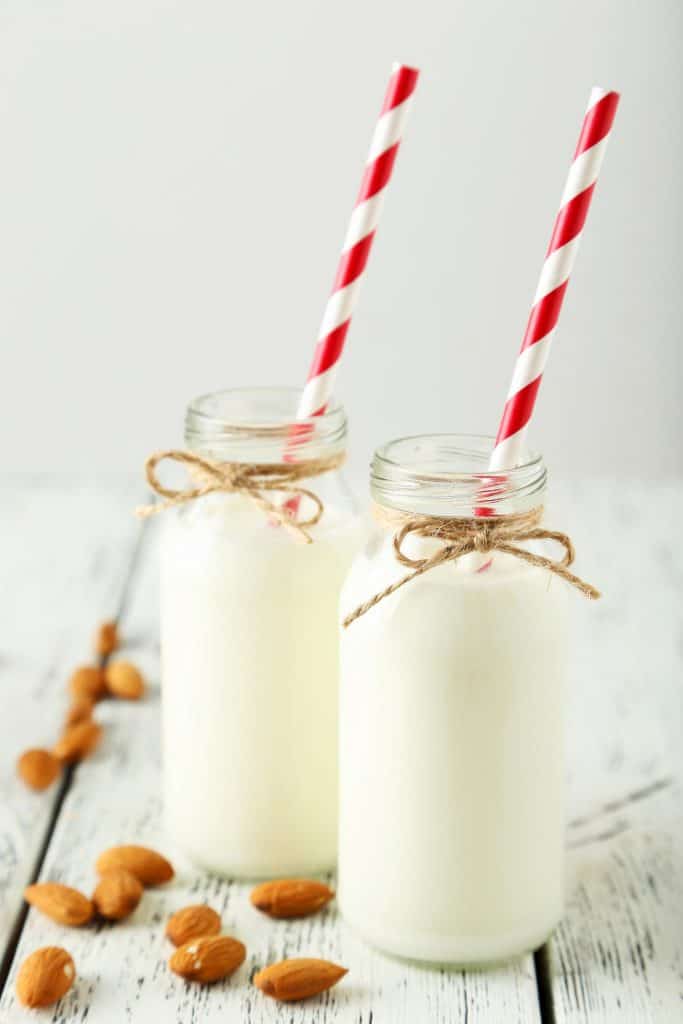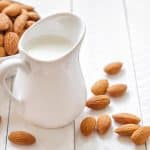![Types of Non-Dairy Kefir [Includes Almond Milk Kefir Recipe]](https://myfermentedfoods.com/wp-content/uploads/2018/04/Depositphotos_29701479_ds-1-1024x682.jpg)
You are vegan, lactose intolerant or just don’t like the taste of milk? But you like the benefits of kefir!?
Fear not!
Because contrary to what most people think, preparing dairy-free kefir is possible. And not only that but it might even taste better than the milk kefir!
The probiotic properties of kefir could enhance your gut health and support the normal functions of vital organs.
If you are looking for ways to prepare homemade kefir and get these benefits without using dairy products, read on to see what your options are and how to prepare it.
Non-Dairy Kefir Types
Water Kefir
Water kefir is fizzy and has a slightly sweet and sour taste. It is considered a healthy probiotic alternative to carbonated soft drinks!
Technically, any kefir that makes use of ‘water kefir grains’ is classified as water kefir even when fruit juices or coconut water is used for fermentation. Here are some types of water kefir you can prepare.
Plain Water Kefir
The traditional water kefir can be made using sugar dissolved into the water. Later, kefir grains are added to it to stimulate fermentation. Water kefir usually has a sweet and tangy taste with a lot of carbonation.
Juice Water Kefir
The water used as the liquid base for preparing pure water kefir can be substituted by fresh fruit juice to ferment juice kefir. You can use the juice of any fruit you like including grapefruits, oranges, sweet lime, watermelons, and grapes!
Coconut Water Kefir
Coconut water kefir is technically similar to juice water kefir. Since the texture of coconut water is quite similar to that of water, it is very light just like pure water kefir.
Coconut water kefir is highly refreshing and a great beverage to drink during warm summer months to stay hydrated.
Dairy-Free Milk Kefir
You can also use dairy-free milk as an alternative to milk for fermenting Kefir. You need to use milk kefir grains instead of water kefir grains to make non-dairy milk kefir.
Dairy-free kefir has a thicker consistency. It is richer and creamier while being more flavorful, thanks to the varied ingredients used as a base. Here are some options of non-dairy milk kefir you can try at home.
Lactose-Free Milk Kefir
Lactose-Free milk kefir is prepared by replacing ordinary milk by non-dairy, lactose-free milk. Other than the people who suffer from lactose intolerance, this type of kefir is also preferred by those who like a creamier and more flavorful drink.
Rice Milk Kefir
It is a popular substitute for milk for patients with lactose intolerance. Rice milk provides a lighter and a less sour taste to kefir. To prepare, you just need to substitute dairy milk by rice milk during the fermentation process.
Oat Milk Kefir
It is one of the best lactose-free milk substitutes that you can use to make thicker and creamier kefir. The starch from oats in oat milk powder helps make kefir sweeter and creamier.
The high-fiber content of oats could further enhance the health and functions of your gut and ease digestive troubles. Oat milk kefir is also recommended for people who are trying to lose weight.
Soy Milk Kefir
Soy milk kefir tastes almost like the dairy milk kefir. It is rich in vitamins and minerals and enhances your body’s nutritional status.
P.S. I do not recommend using soy. I plan to write a post why this is later on. But I’ve included it here so you know you have this option.
Nut Milk Kefir
Nut milk prepared by blending nuts soaked in water can offer a great base to ferment kefir. You need to strain out the fine bits of nuts before using them to prepare kefir. Nut milk kefir is highly nutritious and tasty, thanks to their higher protein content.
While you can use practically every nut out there to ferment kefir, some of them are more popular for being tastier, and healthier. Here is a list of nuts you can use to prepare non-dairy kefir.
- Almonds
- Hazelnuts
- Peanuts
- Macadamias
- Pistachio
- Cashews
- Walnuts
- Pecan nuts

Seed Milk Kefir
Not just nuts, but even seeds can be processed to yield lactose-free milk! However, you must stay away from seeds that are strongly flavored like sesame seeds.
Also, if you wish to incorporate seeds in your kefir recipes for health reasons, add not more than half a teaspoonful so as to avoid altering the flavors drastically. Here are some seeds that can be used to prepare kefir.
- Chia seeds
- Sunflower seeds
- Pumpkin seeds
- Flax seeds
- Quinoa seeds
Coconut Milk Kefir
Just like coconut water, you can also use coconut milk to ferment delicious and super nutritious kefir. It is readily available in most stores making it a convenient choice for preparing non-dairy kefir. If you can get a hold of fresh coconuts, you can easily make coconut milk on your own!
Simply grate the coconut and add the grated pieces to the grinder to make a smooth paste. Strain the paste to extract thick, white liquid and your coconut milk is ready! It makes up for a perfect ingredient to add to your kefir.
Finding Water Kefir Grains
Like milk kefir grains, water kefir grains can be found in health stores, organic stores and online and are typically packaged in a dehydrated state. And they can be reused like milk kefir grains which means you can use them for subsequent batches or share them with your fermented food lovers.
Water Kefir Variations
If you used plain water as base and still like to experiment I recommend try making fruity water kefir by adding some of your favorite fruit combinations. Some of our favourites include:
- adding 500 ml of 100 percent apple or grape juice
- 3 slices fresh lime and 3 slices of fresh lemon
- 2 tablespoons dried figs and 1 tablespoon cumin seeds
- 2 tablespoons blueberries and 2 tablespoons pomegranate seeds
- 2 tablespoons fresh raspberries and 4 tablespoons fresh strawberries
As a result you will get a wonderfully light and refreshing fermented drink full of natural probiotics.
What to Do With Kefir Grains After First Use
Leave the kefir grains left in the strainer for the reuse for subsequent batches. For a short-term use (up to three weeks) mix kefir grains with 1l of water and store it in the glass jar in the fridge.
For a longer-term storage dry the grains by placing them onto paper towel and air-dry for three to five days at the room temperature. Store the grains in a storage container in the fridge for up to six months.
Now that we have learned various alternatives to milk you can use to prepare kefir, let’s check out some great dairy-free kefir recipes.
Print
Almond Milk Kefir
- Total Time: 24 hours 20 minutes
- Yield: 5 cups 1x
Description
This tangy flavored almond milk kefir is very simple and easy to make. You can drink this probiotic-rich beverage once or twice a day or add it to smoothies. This recipe does not involve the use of kefir grains. Yet, you can call it kefir for its sour taste and the rich content of nutrients, especially probiotics.
Almond milk kefir could help rebalance your body’s eco-system, rejuvenate your mind, and restore your vitality.
Ingredients
- 1 cup of raw almonds
- 7 cups of water
- Pinch of salt
- 1 teaspoon of probiotic powder
- Liquid stevia, preferably alcohol-free, or honey
- One tablespoon of apple cider vinegar or fresh lemon juice
Instructions
- Soak almonds in water for 8 to 12 hours by placing them in a ceramic or glass bowl. Add salt and one tablespoon of apple cider vinegar or fresh lemon juice. Add enough water to soak these ingredients completely.
- Cover the bowl with a breathable kitchen towel and allow the almonds to soak for 12 hours at room temperature.
- Drain the water and discard it. Rinse the almonds a few times to remove enzyme-inhibitors and anti-nutrients.
- Add rinsed almonds in the blender and pulse on high for 40 to 60 seconds or until the nuts have been pulverized completely.
- Strain the milk through a nut milk bag or a piece of nylon hosiery. Twist the bag gently to squeeze the milk through it.
- Add probiotic powder and stir it into the almond milk using any wooden spoon. Avoid using a metal spoon as it may damage the probiotics. You can get probiotic powder by opening capsules of any probiotic supplement from a reliable brand.
- Then, cover the bowl with a breathable cloth and allow to stand for 12 to 14 hours.
- After about 12 hours, the mixture would look like a yellowish “almond water” and have a thick foamy layer of scum or fat floating on the top. It would smell fermented just like yogurt or dairy kefir. If the layer is thin and doesn’t have much of odor, allow it to ferment for a few more hours.
- Once done, skim off the layer of fat gently with a spoon.
- Strain the remaining liquid with a fine mesh strainer. Keep aside about half a cup of this liquid as a starter for the next batch of kefir.
- Sweeten the cultured milk by adding a tablespoon of honey or stevia and drink it.
Notes
- You can use a part of the cultured milk as a starter. It can be used as an alternative to probiotic powder to make about 4 to 5 batches of kefir after which you will need to use probiotic powder from a capsule again.
- The skimmed off layer of fats can be used in puddings and smoothies.
- You can store the excess almond kefir in a glass jar in the refrigerator for up to one week.
- You can follow the same recipe to prepare kefir using other nuts. Make sure the nuts are raw and unsalted. Don’t miss the step of soaking the nuts as it makes them softer and easier to blend.
- Prep Time: 20 minutes
- Cook Time: 24 hours
- Category: Fermented drink
- Method: Fermentation
- Cuisine: Caucasus
Conclusion
Dairy-free kefir can just about offer all the health benefits of milk-based kefir. It is simple to prepare and hardly requires any time or effort. You also have numerous options of non-dairy kefir to choose from! So, if you are intolerant to dairy products, you can always start off with non-dairy kefir.
You can drink non-dairy kefir to derive multiple health benefits of probiotics or use it in place of cream in any recipe. You can also add it to your coffee or use it as a base for your favorite smoothie or topping to your favorite dessert. The options are plenty and the benefits are numerous!

I’ve looked everywhere for this exact article, so thank you! Soaking my oats now.
Thank Erika. I hope you enjoy it 🙂
I am confused. Can you tell me the exact kind of kefir starter to buy to use with almond milk?